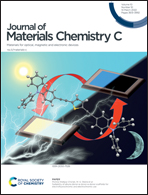Ultrasensitive photoluminescence modification of the Eu3+ ion based on light tuning of the surface potential of the Bi3O4Cl layered semiconductor and application in facile UV light detectors†
Abstract
Combining rare earth (RE) luminescent ions with various types of host materials has proved to be an effective strategy to achieve meliorative or additional optical properties of RE-doped materials. However, for trivalent RE ion-doped inorganic crystals, it is not effective enough due to the fundamental dependence of the radiative rates of 4f–4f transitions on the crystal field (CF). Herein, we report a new and ultrasensitive strategy for tuning the photoluminescence (PL) of Eu3+ ions based on the surface photovoltage (SPV) of the Bi3O4Cl layered semiconductor, instead of regulating the CF. The results indicate that changing the excitation light from ultraviolet (UV) to visible light sensitively changes not only the radiative rates and branch ratio but the crystal field splitting of the electric dipole transitions (EDTs) of the Eu3+ ions as well. By fixing the excitation light in the UV band, the layered phosphor allows for the light-control ability of the EDT splitting ratio of Eu3+ ions (adjustment accuracy less than 0.01 mW cm−2). The results show that the light-tunable SPV, which is associated with efficient photocharge separation in a space charge region, not only changes the polarization intensity around the Eu3+ ions but also restrains the radiative transitions of the excited electrons. Besides providing insights into the tunable PL performance of RE3+ dopants relying on excitation light and crystal structure, the result of this work indicates the implementability of the light-controllable spectroscopic fingerprints of Eu3+-doping phosphors towards UV light detection.



 Please wait while we load your content...
Please wait while we load your content...